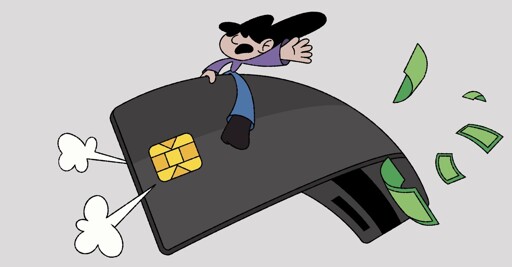I don’t mean to shock you, but being a coal miner at the turn of the 20th century was not super fun. The work was dangerous, unpleasant, and low paid. The industry was extractive and poorly regulated. The people who ran it could be irresponsible and indifferent to human suffering. Also, the shopping was abysmal—when you wanted groceries or new clothes, you generally had to buy whatever was available at the company store, often using scrip: fake money issued by your employer as credit against a future paycheck. Even if you felt like you had consumer choice, you were really locked into a closed system run by one company, your life weirdly governed by something sort of similar to—but fundamentally different from—actual money.
I was thinking of the coal miners because Chase recently changed the terms on its highest-end consumer credit card, the Sapphire Reserve. Most notably, the annual fee increased by nearly 45 percent, from $550 to $795. That hike was theoretically to be offset by an increase to the card’s rewards, which are now purportedly worth $2,700 annually, offered not in the form of legal tender but rather as a long and complex list of credits, many of them issued in the conditional tense. For example, you can get $500 off stays at hotels—if those hotels are on a special list picked by Chase, and if you book for at least two nights. And the credits are actually meted out in chunks, so to get the full reward, you need to book two different stays: one in the first half of the year, the other in the second. You also get a host of similarly caveated coupons to Chase’s corporate partners—Apple, StubHub, DoorDash, Lyft, Peloton. The line item advertising $300 in DoorDash promos reads like an ancient riddle: You can get up to $25 off each month, though only $5 can be used on restaurant orders, and $20 can go to two separate grocery or retail orders. (I have omitted the asterisks, of which there are many.) It is technically possible to save money—if you can figure out how to do it.
To be clear, being a coal miner in 1903 was pretty different from being a high-net-worth individual in 2025. But not completely different: As coal mines did for their miners, today’s credit-card issuers have essentially invented their own fiat currency—“points,” usually—that can be redeemed only within their apparatus, for rewards the company has designated, at an exchange rate that it can change at will. Three out of every four credit cards are now rewards cards: They are how Americans, especially rich ones, shop. As the cards get more popular, though, reaping their benefits is becoming harder and more like homework. Last year, the Consumer Financial Protection Bureau reported a 70 percent increase in complaints about points-issuing credit cards since 2019: The agency found card issuers hiding complex redemption requirements in fine print, forcing borrowers to use janky proprietary portals to book rewards travel, and failing to resolve technical glitches or customer-service issues, among other things. The report concluded that 82 cents out of every dollar in rewards that American credit-card holders earned in 2022 went unclaimed at the end of the year—a 40 percent increase since 2019. In effect, credit-card companies are selling consumers a book of coupons they are unlikely to use.
The Sapphire Reserve is a fascinating product. It costs money, but it’s not exactly something you buy. You can’t sell it, because it has no inherent market value. But it comes packaged like a $10,000 watch and is advertised via perplexing billboards designed to make the card look like a high-fashion accessory, which maybe it kind of is. At any rate, the message is not subtle: This is a fancy card for fancy people. It enables the purchase of luxuries, and is itself a luxury.
When the Reserve was introduced, in 2016, the highest-status credit card on the market had been the American Express Centurion, which you may know from rap music and James Bond as the Black Card, and which was available by invitation only. The Reserve, though, required only decent credit and a willingness to shell out for a sizable annual fee. It kicked off a new era in spending money: “That’s where we really saw this premium-card market go mainstream,” Nick Ewen, a senior editorial director at the credit-card-review website The Points Guy, told me. The Reserve, and cards like it—most notably Capital One’s Venture X and American Express’s Platinum—had high fees, high rewards, and high-spending customers who dined out and traveled a lot. Like the Centurion, they signaled exclusivity, but in a different way: The Black Card’s conspicuous consumption largely involved shopping; the new cards were for consumers who prioritized experiences. They advertised by using imagery of hot urbanites at restaurants and on vacation, their lives rich with money but also adventure. “What they did was they made it about your values,” Stephanie Tully, a consumer-behavior expert at the University of Southern California, told me. Wealth wasn’t just about how much you had; it was about how you spent it. Literally.
[Read: There are two kinds of credit cards]
And spending is what card issuers are hoping you will do. The Reserves of the world generally make money not from the interest on unpaid balances but from transaction fees charged to businesses. In other words, these cards want you swiping. They encourage it by offering benefits—fat introductory bonuses, cash back on all kinds of purchases, ungettable restaurant reservations, access to airport lounges. Recently, they have gone beyond flat-rate rewards and added more and more complex, hyperspecific perks onto the pile, partnering with businesses that are happy to offer the card companies a discount in exchange for access to their customers. Card issuers have also increased their annual fees, presumably betting that people will either not notice or not care, and that they will happily trade real money for fake money, or at least the promise of it.
Rewards make the consumer feel in control and empowered, as if they’re making money even while they spend it. They reduce what behavioral economists call “pain of payment”: They make parting with your wealth feel fun, as if you are a video-game protagonist collecting magic stars, even when you are buying diapers or booking flights to a funeral. Rewards seem somehow different from normal currency. “It’s not your income minus your expenses; it’s just this extra pool of money that has been accumulating through other things that you do,” Tully told me. “It feels like free money”—like a windfall or winning the lottery, even if you paid hundreds of dollars for the right to earn the rewards in the first place. In a 2024 poll, 37 percent of rewards cardholders said they’d spend less on their cards if points weren’t offered.
In 2023, the CFPB received 1,200 complaints about credit-card rewards across a number of brands. Cardholders report that rewards are devalued, denied, disappeared, or fine-printed to oblivion, their actual redemption details dramatically different from their marketing materials. They are often subject to dynamic pricing; sometimes, a card’s portal will glitch, and the number of points required to book a flight or hotel will spike. Sometimes, the airport lounge that a customer is theoretically entitled to is full, crowded with all of the other people who are also trying to maximize their rewards. Sometimes, dealing with it all is just too complicated—hence, all of the unredeemed credit-card points.
[Read: A fancy card is becoming the only way to get a restaurant reservation]
Of course, nobody emails the government about how much they love their credit card, and an unredeemed point is not necessarily a wasted one. Still, Ewen has noticed that his readers—who presumably have a more sophisticated understanding of credit-card rewards than the average person—are having a hard time figuring out how to use theirs. People are so flummoxed by the logic puzzle of spending their points that they sit on them, something he called “analysis paralysis.” But, he told me, that’s not a great strategy, because card companies reserve the right to change terms whenever they want. Suddenly, points that were worth $300 might be worth much less. The Points Guy’s official stance on rewards is “earn and burn,” Ewen said: “Points are not a long-term investment.”
Ewen has 24 credit cards, and he loves to get the most out of them. Every year, he sits down and crunches the numbers to make sure he’s made back his annual fee on each of his cards. This is both his job and his hobby—he’s a points guy! But not everyone is. “For some people, it absolutely is kind of like a game,” Tully said. But, she said, even for the people who don’t think about credit-card points for a living, “it can become a job almost.” Consumers, she continued, need to weigh “how much time and effort they want to put into their credit cards when they’re choosing what credit card to buy.”
Fancy cards are like coupon books or miners’ scrip, but they are also, in this sense, more like high-end gym memberships. The commodity they offer is access to a rarefied place, one where everyone else is attractive and competent, putting in the work and reaping the rewards. The product is a subscription to do more work—it’s a tax on laziness or a deposit on your future self’s conscientiousness. But it seems to me that credit-card companies, and gyms, know something consumers don’t: Everybody thinks they’ll be a more diligent person tomorrow.
From The Atlantic via this RSS feed


